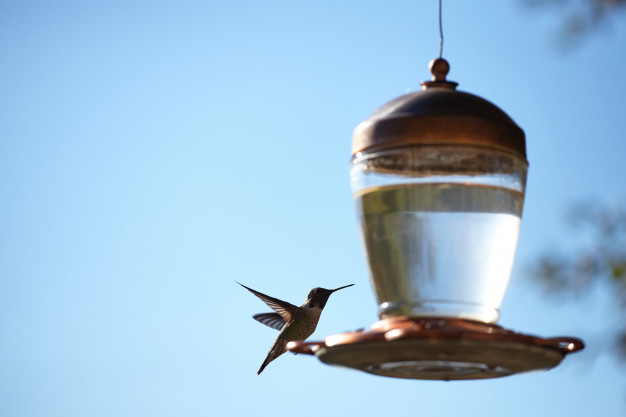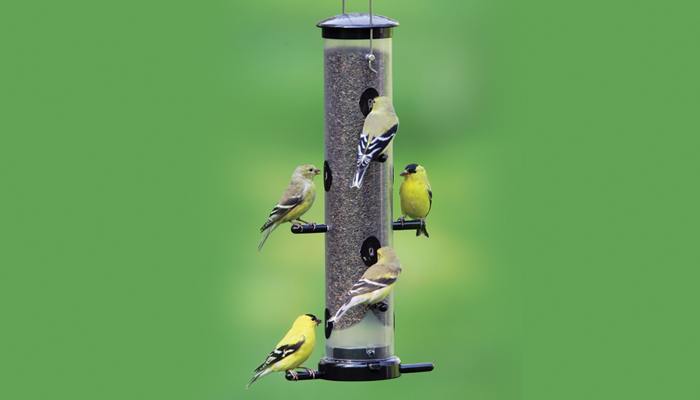A woodpecker is a bird that is known for pecking holes in tree bark. The main reason behind the pecking of the trees is to find insects to eat. Woodpeckers are very attractive and interesting visitors to bird feeders. In addition to adding beauty to the landscape, woodpeckers are an integral part of the ecosystem. Woodpeckers mostly live in forests and they normally spend their lives in trees they are also called primary cavity nesters,
Woodpeckers live all over the world. The maximum numbers of them are found in South America and Southeast Asia. They can be found worldwide except in Australia and New Guinea. Experts and scientists divide woodpeckers into different groups, talking about the types and species there are almost more than 180 types or species, of woodpecker. They include the birds called flickers and sapsuckers. Woodpeckers look like songbirds in many ways. Most types of woodpecker eat insects found in tree bark. A woodpecker often uses its bill to tap holes into the bark. This normally does not hurt the trees. In fact, woodpeckers eat insects that are harmful to trees. Some kinds also eat fruit. Sapsuckers also feed on sap, a liquid made by trees. Flickers eat mainly ants on the ground.
Species of woodpecker:
Woodpecker can be found in almost all parts of the world except Australia and New Guinea. Therefore, there are approximately 217 species of the bird worldwide. If we talk about North America, there are almost 22 breeding species of woodpeckers. They are further grouped into four different tribes, which, respective of descending size, are Campephilini, Colaptini, Mealnerpini, and Camphetherini. Piculets are the smallest type of woodpeckers, which measure 3 to 4 inches long. These types of woodpeckers can be found in Africa, South America, and Asia. Melanerpes species Woodpeckers eat fruits and berries. The acorn woodpecker is normally found in the woodlands of western North America. The existing mainly depend on acorns for food during the winter. Similarly, the red-headed woodpecker (Melanerpes erythrocephalus) is dispersed in temperate North America.
The hairy woodpecker is found in temperate North America.
The downy woodpecker is found in the woodlands of temperate North America. The great spotted woodpecker (Dendrocopos major) inhabits the forests of western Eurasia located south of North Africa.
The species of Dryocopus include the black woodpecker, which is size is up to 18 inches long, and the pileated woodpecker, which is 15.5 to 18.25 inches long. The Dryocopus species are known to be large and fast at flying.
The next species we discuss here is the three-toed woodpeckers. There are two species of three-toed woodpeckers. The first one is black-backed three-toe and the other is a northern three-toed woodpecker.
The crimson-backed woodpecker is commonly found in woodlands in India and the Philippines.
The green woodpecker (Picus viridis) is found in temperate Eurasia.
The red-cockaded woodpecker inhabits pine forests in the southeastern United States.
The ivory-billed woodpecker (Campephilus principalis) is a critically endangered woodpecker originally found in Cuba and the southern United States and was rediscovered in eastern Arkansas in 2006.
Size of Woodpeckers:
The size of Woodpeckers varies in length from 6 to 18 inches while in centimeters from 15 to 46. They are often black and white with patches of red or yellow on the head. Let’s discuss the complete body shape and physical attributes of woodpeckers.
Coloring of Woodpecker
Most of the woodpeckers have black and white feather patterns with patches of red or yellow on their heads or breasts. Spotted, striped, and barred feather patterns help camouflage them in their forest habitat. Although there are some exceptions, the chestnut-colored woodpecker of Mexico and Central American is brown, and Lewis’s woodpecker, found in British Columbia and the western United States, has beautiful green-black wings, tail and head with a salmon breast, red face and gray color.
Beaks
Woodpeckers have strong beaks and powerful necks to help them drill into trees, cacti, and soil to find food. They drill into trees to extract wood-boring insects, and their hammering noise can be heard for miles. Hammering woodpeckers have thicker, stronger beaks, while woodpeckers who use their beaks for probing have longer, thinner, more curved beaks. Also, woodpeckers have long, sticky, barbed tongues that extend beyond the beak to use during insect extraction.
Plumage of Woodpecker:
As the woodpecker has a large number of species, Due to which they vary greatly in plumage. They can be found in different colors, Like black, brown, red, yellow, or other hues. Sometimes color differences among a species signify sex, as many males have redhead patches, while females do not. Though all woodpeckers are sexually dimorphic, it is very difficult to determine the sex of woodpecker from their visual characteristics.
Bill and Tongue of Woodpecker
Bill of a woodpecker is a chisel-shaped tool that has evolved specifically for excavating food from wood. Some woodpeckers have bills with slight curves, while others have shorter, straighter bills.
The tongue of a woodpecker’s can be up to 4 inches long and is extremely efficient at removing ants or other bugs from wood due to its barbed and sticky surface. It can also be used to slurp up sap from trees.
Feet and tail feathers of Woodpecker
Feet of Woodpecker are molded for climbing. They have two pairs of toes. One pair point forward and the other point backward. Their fourth toe can bend sideways. Bending sideways gives the bird greater flexibility while climbing and pecking at trees.
While talking about the tail feathers, the tail feathers of the woodpecker are also crucial for pecking. These feathers are extremely stiff and supported by a number of large muscles. The wedge shape of their tail feathers and their height give woodpecker’s additional support and create an ideal posture during pecking.
Also, the woodpecker has a number of special adaptations in its body to protect its internal organs, specifically its brain, from damage during packing. This is important, as some woodpeckers will deliver over 10,000 pecking blows in a single day.
Vocalization
The voices of woodpeckers tend to have a loud and rattled pitch to match their loud hammering activity. One exception is Lewis’s woodpecker, which rarely makes any vocal noises. Many woodpeckers make chuck-chuck-chuck noises or a repeated churrr. Some seem to scold each other or give warnings with loud rattling noises.
Breeding
The mating and nesting behavior of woodpeckers is different for each species. It ranges from compassionate to violent. Though there are a variety of woodpecker species, many of the members of this group share similar mating qualities. Woodpecker copulation lacks any sort of ceremony. The female assumes the breeding position while stretched out on a branch and the male mounts her from behind. Eggs are typically laid in the morning and the size of the clutch is between four and six eggs. The process can be further discussed below.
- The male and female parents work together to dig up a cavity in a tree where eggs can be incubated for approximately two weeks.
- The eggs are incubated for 11 to 14 days before hatching.
- A newly hatched woodpecker is blind and featherless.
- To protect their young, one parent must stay in the nest while another goes on to hunt food and bring it to the nest.
- The young woodpeckers should be ready to leave the nest after 25 to 30 days.
Types of Woodpecker
As earlier discussed, there are more than two hundred species of woodpeckers. let’s discuss some main types of woodpeckers that are mostly found USA.
Acorn Woodpecker
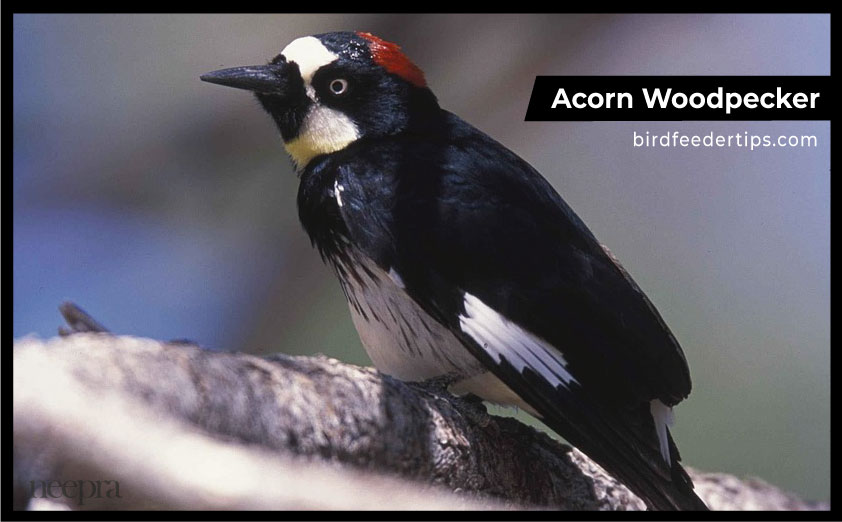
This type of woodpecker is mostly found in the U.S.A and Canada. According to the experts, the approximate population is 2,000, 000. The main habitat of this species is oak trees. During fall season Acorn Woodpecker groups choose a “granary” tree into which they drill holes to store acorns. A single granary tree can sometimes hold up to 50,000 acorns.
American Three-toed Woodpecker
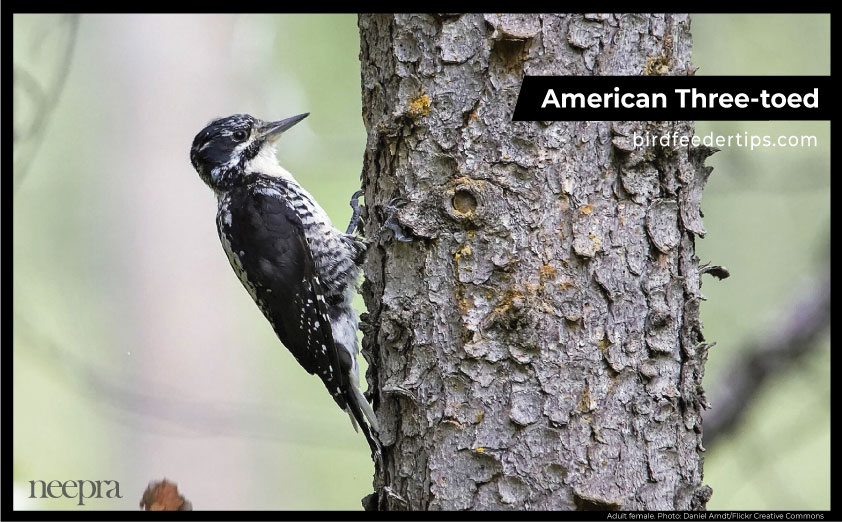
This type of woodpecker is generally dark with barred flanks and subtle white spots on wings and back. while the Face is black with white stripes above and below the eye and white speckles on the forehead. There is a logic that Eastern birds are darker than western birds. Males woodpeckers show yellow patch on crown; sexes otherwise alike. Most similar to Black-backed Woodpecker but American Three-toed always shows some white on back and whiter on the head. This is one of the rare cases woodpeckers, the population trend is decreasing these Woodpecker populations have declined by more than 25 percent since 1970. According to the survey in U.S./Canada Population Estimate is 1,400,000.
Arizona Woodpecker
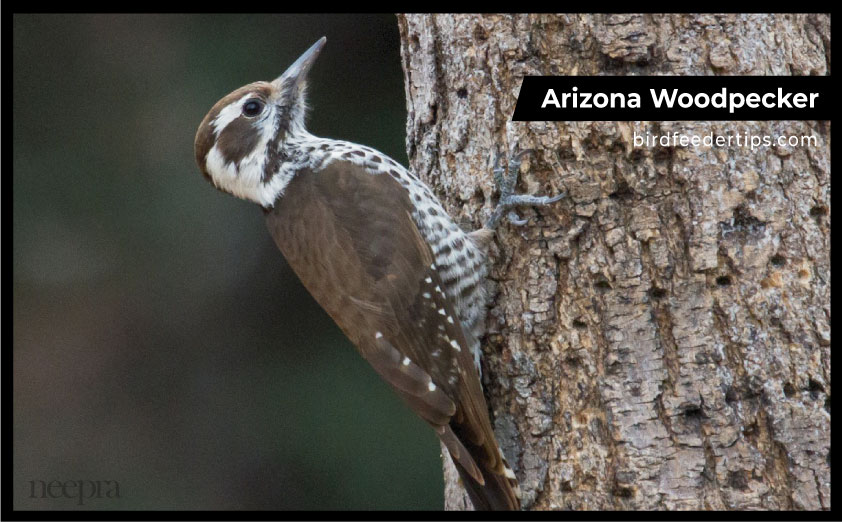
In the early stages the Arizona Woodpecker was once considered conspecific with the Strickland’s Woodpecker, but now they are considered a separate species by most authorities. This type of woodpecker is a bird of Mexico, with a range that just crosses into the United States in extreme southern Arizona and New Mexico. As with many Dry bates woodpeckers, males and females are very similar in appearance, except the male has a red patch on the back of his head. While at first glance they may appear to be similar in shape and structure to other North American woodpeckers’ species, but they are the only North American woodpecker with a solid brown back. These types of woodpeckers are mostly found in lower to mid-elevation oaks and oak-pine woodlands. The common feed is mostly on insects, especially on the larvae of wood-boring beetles.
Black-backed Woodpecker
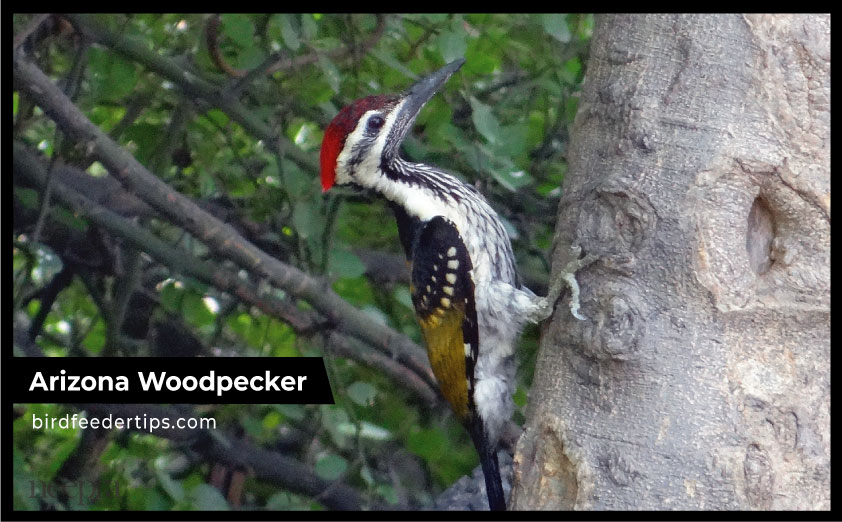
This type of woodpecker has solid black upperparts, black tails with white outer tail feathers, light breasts, and dark barring on their sides and flanks. The heads are mostly black with prominent white moustachial stripes, and males have yellow crown-patches. Like American Three-toed Woodpeckers, they have three rather than four toes on each foot. They are slightly larger than Three-toed woodpeckers and can be distinguished from them by their solid black backs. Their black plumage serves as excellent camouflage in the charred areas they prefer. These types of woodpeckers are found in Washington. The common habitat for this type of woodpecker is old-growth conifer forests, especially forests of spruce, larch, fir, pine, and hemlock. They are attracted by fire and they visit instantly when they knew about the fire zone. The common feed is wood-boring beetle larvae, insects, and fruits.
Downy Woodpecker
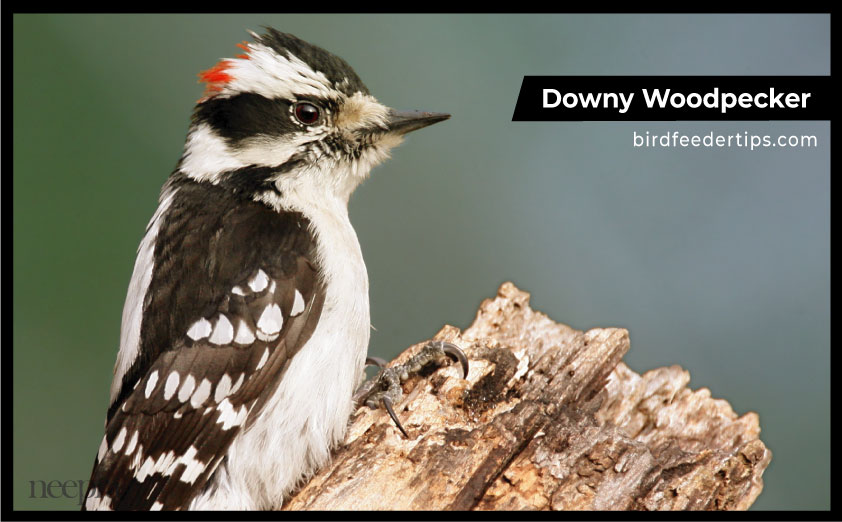
The Downy Woodpecker is the smallest woodpecker in the United States. The plumage of Downy Woodpecker is a mix of black and white. While Its wings, lower back, and tail are black with white spots; its upper back and outer tail feathers are white. The underside of the Downy woodpecker is white, and its head is marked with wide alternating black and white stripes. Males have a red spot at the backs of their heads which females lack. Downy Woodpeckers closely resemble the larger Hairy Woodpeckers, but Downey’s have relatively smaller bills, which give their heads a rounder, ‘cuter’ shape. Downy Woodpeckers found in western Washington are considerably darker than their eastern Washington counterparts, with most of the areas described above as ‘white’ actually a dingy tan. Juveniles look like adults but may have red on their foreheads. The estimated population of downy woodpecker is 13,000,000.it can be seen in the picture below.
Gila Woodpecker
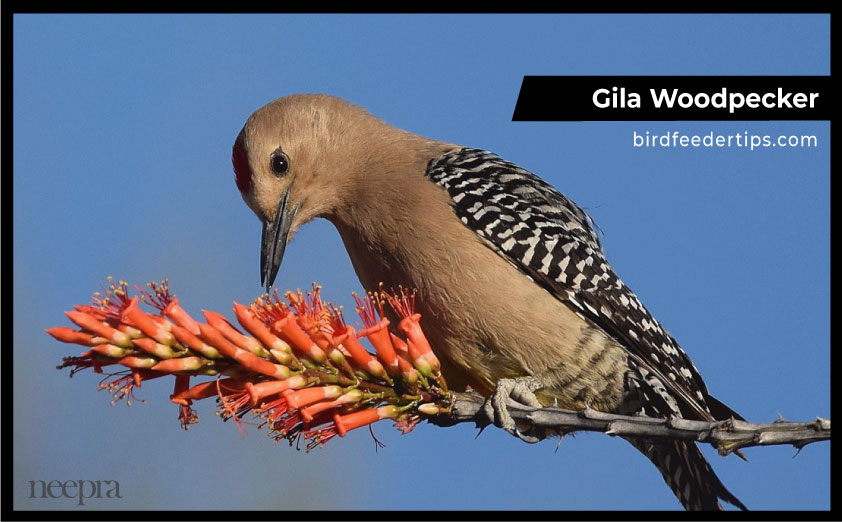
The Gila Woodpecker belongs to a desert-dwelling species. Like other woodpeckers, it does not nest in dead trees instead. It prefers to raise its young in cavities within living Saguaro cacti. Gila woodpeckers have a brown face, black and white zebra-striped back, and white wing patches that are visible during flight. Both males and females almost have the same characteristics but adult males have a red cap of feathers on the top of their heads. This type of woodpecker is decreasing rapidly and If current rates of decline persist, Gila Woodpecker populations may be halved in 50 years.it can be found in, southern Arizona, southeast California, southwest Nevada, southwest New Mexico, and south into central Mexico. It mainly eats insects, but they will also eat mistletoe berries, cactus, and other seasonal fruits.
Gilded Flicker
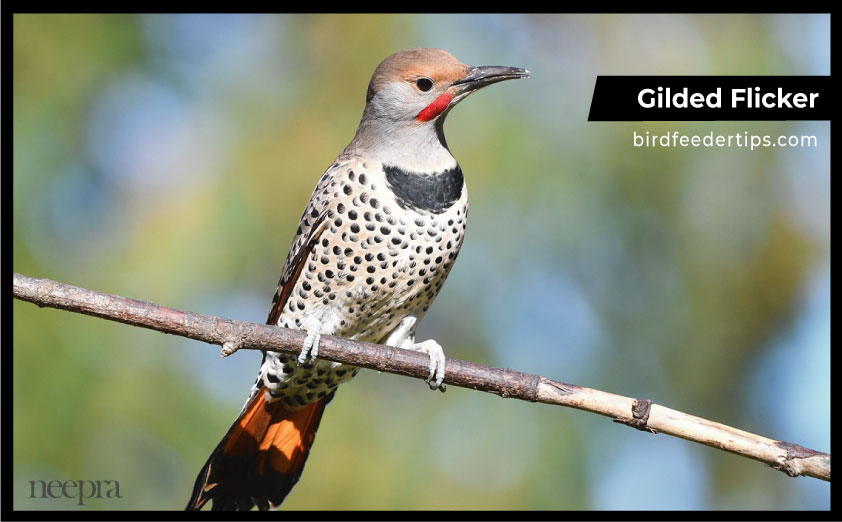
The gilded flicker is a large-sized woodpecker having an approximate length of 11 in (29 cm). It can be found in the Sonoran, Yuma, and eastern Colorado Desert regions
of the southwestern United States and north-western Mexico, including all of Baja California, except the extreme north-western region. The Golden-yellow underwings distinguish the gilded flicker from the northern flicker found within the same region, which has red underwings. The main habitat of this type of woodpecker is saguaro cactus, riverside groves, and Desert scrub. These are very rare and the populations of this type of woodpeckers have declined by more than 50 percent over the last 50 years. It is a species of conservation concern and has been added to PIF’s Yellow List.
Golden-fronted Woodpecker
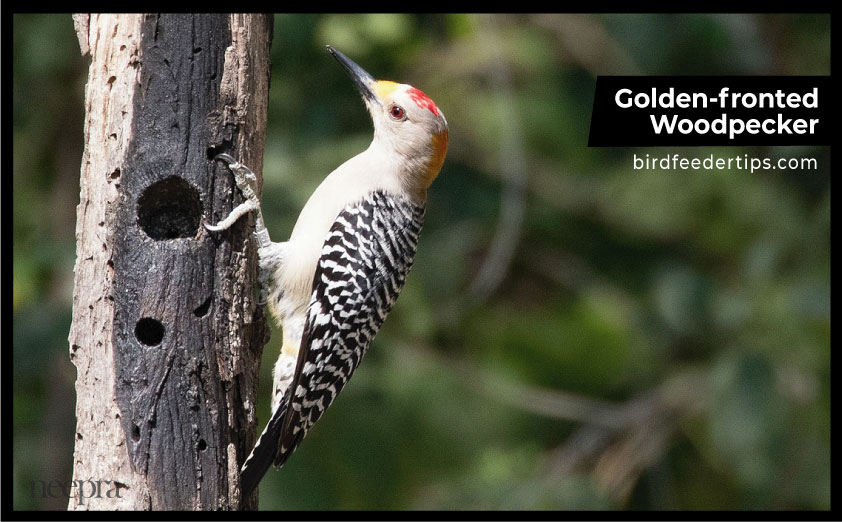
The Golden-fronted Woodpeckers can be found in Mexico and Central America. While in the United States, they can be found in Texas and a small portion of Oklahoma. It crosses the border mainly in southern Texas, where it is very common, noisy, and conspicuous. Similar in appearance and behaviour to its relative, the Red-bellied Woodpecker. It searches tree trunks and limbs for insects and gleaning them from bark or probing below the surface. They Clamber in branches of trees or shrubs to pick nuts, berries, or fruits. The eggs count from 4 to 7.the incubation period ranges from 2 to 14 days. The Young leaves the nest about 30 days after hatching. The population trend of Golden-fronted woodpecker is decreasing. The main threat of its degradation is that they are harmed by pesticides and habitat degradation. The current U.S./Canada Population Estimate of The Golden-fronted Woodpeckers is 820,000.
Hairy Woodpeckers
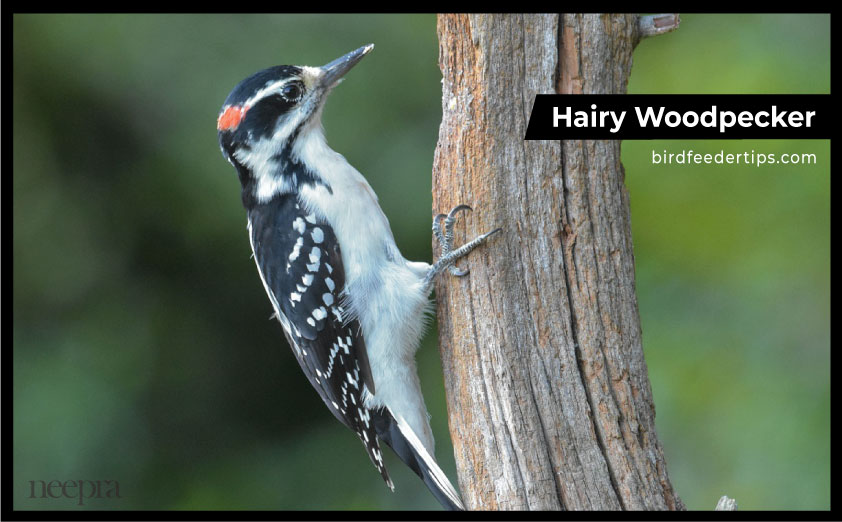
The name of Hairy Woodpecker is due to the long thread-like white feathers that run down the middle of its black back. Hairy woodpecker looks like the Downy Woodpecker, but it has a heftier bill. It’s also larger, measuring 9 to 10 inches in length. The Hairy Woodpecker has some distinct properties. It is much shier, more retiring bird than the confiding little downy. it is also more active and noisier. it usually not allows close approach but will dodge around the trunk of a tree or fly away. If an intruder comes near it, it bounds through the air in a series of graceful dips and rebounds. There are more than 15 subspecies of the Hairy woodpeckers. The main habitat is Eastern and western forests. Sometimes Hairy Woodpecker follows Pileated Woodpeckers, inspecting the larger birds’ excavations for overlooked insects. Similarly, they drink sap from excavations made by sapsuckers.
Ivory-billed Woodpecker
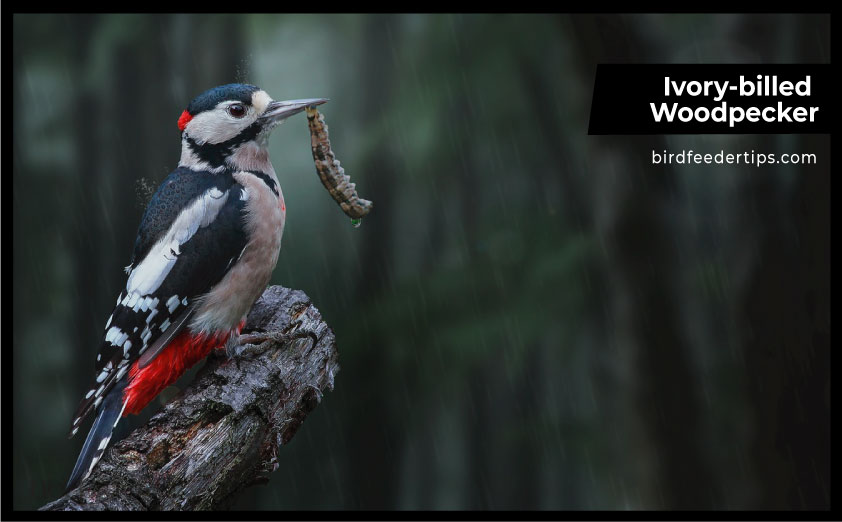
This type of woodpecker is the third-largest in the world while the largest of the woodpeckers north of Mexico. The size is roughly 51 centimeters (20 in; 1.67 ft) long and 76 centimeters (30 in; 2.49 ft) in wingspan. The Ivory-billed Woodpecker was a bird of old-growth forests in the southeastern U.S. and Cuba. Its habitat was destructed by the wild forest fire. Due to which it disappeared. Very less amount of the birds escaped and they reappeared in the “Big Woods” region of eastern Arkansas in 2004. The ivory-billed woodpecker is thought to mate for life. Pairs are also known to travel together. These paired birds mate every year between January and May. Both parents work together to excavate a cavity in a tree about 15–70 feet (4.6–21.3 m) from the ground before they have their young, with the limited data indicating a preference for living trees, or partially dead trees, with rotten ones avoided.
Ladder-backed Woodpecker
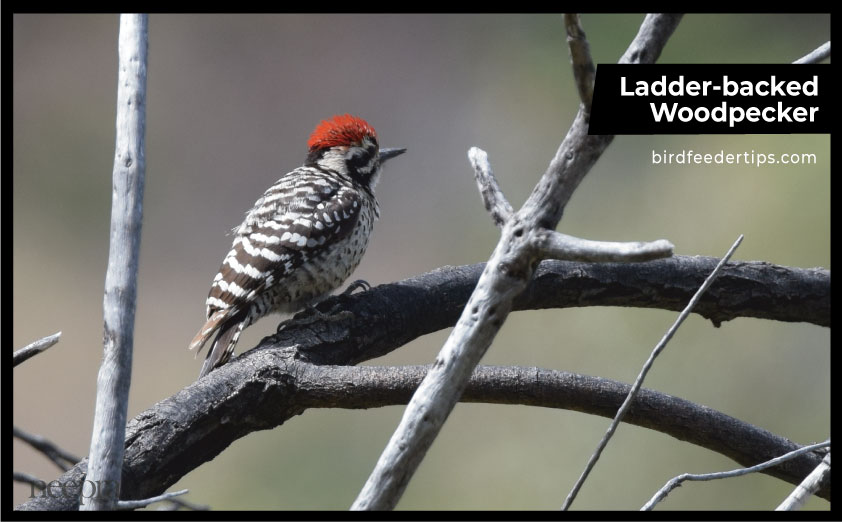
This bird Ladder-backed Woodpecker was formerly known as the “Cactus Woodpecker,”. It is found throughout Mexico. It ranges from Texas to California in the U.S., where it thrives in dry habitats including mesquite thickets and pinyon-juniper forest. It can also be found in pinyon pine and pinyon-juniper forest. Like many small dwellers of arid habitats, Ladder-backed Woodpeckers can be inconspicuous and quiet, requiring a bit of time and patience to find. Their small size and agility make them deft foragers among the thorns and spines of plants like cholla, mesquite, and prickly pear. The population trend of the Ladder-backed woodpecker is stable and according to a report the current population in the US is 2,100,000.
Lewis’s Woodpecker
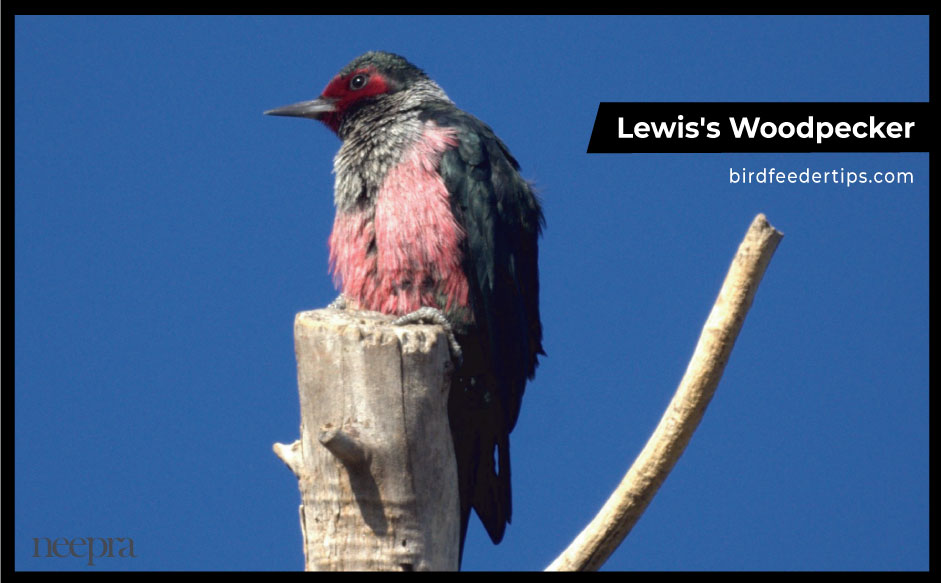
Lewis woodpecker is one of the oddest woodpeckers due to its colors, which include silver, pink and oily green. These were first discovered during the Lewis and Clark expedition of 1804-1806, and named for the expedition’s co-leader. Although it climbs trees in woodpecker style, it feeds mostly by catching insects in acrobatic flight, swooping out from a perch like a flycatcher, circling high in the air like a swallow. Wide rounded wings give it a more buoyant flight than most woodpeckers. In fall, Lewis’s Woodpecker chops up acorns and other nuts, stores them in crevices, then guards the storage area for its winter food supply. The number of eggs ranges from 6 to 9. While the incubation is done by both male and female for 12-16 days, the young leave the nest after 4 to 5 weeks of incubation. The habitat is Dry, open western forests while the species is decreasing rapidly due to Changes to forest composition due to fire suppression, grazing, logging, and climate change.
Northern Flicker
The northern flicker or common flicker is a medium-sized bird that belongs to the woodpecker family. It is native to most of North America, parts of Central America, Cuba, and the Cayman Islands, and is one of the few woodpecker species that migrate. The natural Habitat are Eastern and western forests. They have barbed tongue which they use to quickly snatch up invertebrate prey. There are different types of the Northern Flicker containing southern yellow-shafted flicker, northern yellow-shafted flicker, Cuban yellow-shafted flicker, Grand Cayman yellow-shafted flicker, and western red-shafted flicker. These can be found in different parts of the USA.
Nuttall’s Woodpecker
Nuttall’s Woodpeckers are found primarily in California’s oak woodlands, but they do not eat acorns. Instead, they mainly subsist on an insect diet including beetles, termites, and ants. Nuttall’s Woodpecker extends only a short distance into Baja and rarely strays to Oregon. Within its limited range, it is often common wherever oak trees grow. It may go unseen at times because of its habit of foraging among densely foliaged oaks, but it frequently announces itself with sharp calls. Despite its close association with oaks, it tends to dig its nesting holes in other kinds of trees, and it eats only small numbers of acorns. The number of eggs is from 3 to 6. The incubation is done by both sexes. While the incubation period is 14 days, the young one can leave the nest after four weeks. The population trend of Nuttle is positive and is increasing day by day.
Pileated Woodpecker
This type of Woodpecker is one of the biggest and most striking forest birds in North America. The size of the pileated woodpecker is almost the size of a crow, black with bold white stripes down the neck and a flaming-red crest. They always look for, carpenter ants in dead trees and fallen logs. This type of woodpecker drills unique rectangular holes in the wood and trees. The nest holes these birds make offer crucial shelter to many species including swifts, owls, ducks, bats, and pine martens. If there are any dead or dying trees or snags in a field there will be a maximum possibility that the Pileated Woodpecker would be there. There is a cool fact that the feeding excavations of a Pileated Woodpecker are so extensive that they often attract other birds. Other woodpeckers, as well as House Wrens, may come and feed there. The habitat of pileated woodpecker are Eastern and north-western forests.
Red-bellied Woodpecker
The red-bellied woodpecker is zebra-backed. It has a black & white barred back, white upper tail coverts, greyish-white underparts, black chevrons on the lower flanks and under tail coverts, and barred central tail feathers It is mostly found in the eastern woodlands and towns. The Length of the RE-Bellied woodpecker ranger up to 9 inches. Red-bellied woodpecker is like Golden-fronted woodpecker. It sounds like churrr and sometimes it also gives a conversational chiv chiv. Like other woodpeckers, Red-bellied Woodpeckers are also cavity-nesters. Although they sometimes they evict smaller Red-cockaded Woodpeckers from nest sites, Red-bellied themselves are more often displaced by European Starlings. The population is almost stable. Its range has expanded to the northward in the Great Lakes region and New England over the last century and is also expanding north-westward in the Great Plains.
Red-breasted Sapsucker
The red-breasted sapsucker is a medium-sized woodpecker. It can be found in the forests of the west coast of North America. Adults Red-Breasted Sapsucker has a redhead and upper chest. they have a white lower belly and rump. While their back and wings are black and bars on it. They have a large white wing patch. Red-breasted sapsuckers nest in tree cavities. Northern birds migrate to the southern parts of the range; birds on the coast are often permanent residents. The breeding habitat of Red-Breasted Sapsucker is usually forest that includes pine, hemlock, Douglas-fir, fir, and spruce, though they are known to use other woodland habitats. They live in living trees which provide them sap for feeding. The holes which red-breasted sapsucker drill to harvest sap are also called sap wells which provide some hummingbird species with an additional food source. The population trend of Red-breasted sapsucker is stable and increasing day by day.
Red-cockaded Woodpecker
Red-cockaded Woodpeckers have short and straight bills. Although its name is Red-cockaded woodpecker but they are largely black and white, with a large, bright-white cheek patch and a bold black malar stripe forming the lower border of the cheek. Males woodpeckers have a tiny and nearly invisible red streak (“cockade”) at the upper border of the cheek. While the back has strong horizontal black-and-white bars. Its length ranges up to 7.9-9.1 in (20-23 cm) and Wingspan up to 14.2 in (36 cm). Red-cockaded Woodpeckers live in family groups and cooperate to raise young while they excavate nest and roost cavities in living pine trees, pecking holes in the bark to keep a flow of sticky pitch around the nest cavity.
Red-headed Woodpecker
The red-headed woodpecker is a small to medium-size woodpecker from temperate North America. Their breeding habitat is open country across southern Canada and the eastern-central United States. The population of Red-headed woodpeckers have declined by almost 70% in the past fifty years. Also, the birds are listed as Near Threatened on the IUCN Red List and have been placed on the State of the Birds Watch List. It store nuts like Acorn Woodpeckers, eat fruits, and can catch insects on the wing-like flycatchers.
Red-naped Sapsucker
The red-naped sapsucker is a medium-sized woodpecker that is mostly found in North American. It is the subspecies of the sapsucker. While talking about its length and weight the length of the red napped sapsucker is up to 19–21 cm long while the weight is 32–66 g. Adults red-napped sapsucker has a blackhead and a red forehead, white stripes, and a red spot on the nape, the lower belly and rump are white while the breast and upper belly is yellow. They are black on the back and wings with white bars. They have a large white wing patch. Adult males have a red throat patch; for females, the lower part of the throat is red, the upper part white. The habitat is mixed forests in the Rocky Mountains and Great Basin areas of America. Red-naped sapsucker lays eggs from 3 to 7, The incubation period is up to thirteen days. The young leaves nest after 29 days.
White-headed Woodpecker
This type of Woodpecker is the only North American woodpecker having a black body and a white head. As it is clear from the name It has white wing-patches at the wrist. The white patches are visible when the bird is perched and when it flies. Males white-headed woodpeckers have a red patch on the back of their crowns. The habitat is Western pine forests. Like other woodpeckers they hammer into wood for insects, they find prey by peeling away tree bark and investigating needle clusters. They are found in mountainous pine forests in parts of the West. White-headed Woodpeckers are listed as Critical in Idaho and Sensitive in Oregon where Ponderosa Pine logging has been extensive. The overall status of the population rate is decreasing. The main source of the decrease is fire suppression, Habitat loss and fragmentation, and snag removal.
Williamson’s Sapsucker
This type of woodpecker belongs to a medium-sized woodpecker family. The body measurement of Williamson’s Sapsucker are as below. The Length is 8.3-9.8 inches, Weight is up to 44-55 g, and Wingspan up to 17 inches. There is a huge difference in the color of male and female Williamson’s Sapsuckers. While a normal person assumes it to be a different species. Male Williamson’s Sapsucker have sport colorful plumage with highlights of red and yellow, females have a more subdued, barred appearance, resembling small flickers. They have some unique characteristics as They excavate a new cavity each year, while sometimes reusing the same tree. The main food source during the nesting season are insects. Also, they feed on sap from conifers, and they also eat berries outside of the breeding period. The population rate is increasing.
Yellow-bellied Sapsucker
The Yellow-bellied sapsucker can be found in the boreal and eastern parts of North America. This type of species is the most highly migratory woodpecker. During the winter season, all of these types’ birds leave their breeding grounds in the northern U.S. and Canada. The Length of the Yellow-bellied Sapsucker is up to 8 inches and an average weight of 50.3 grams. While the wingspan ranges from 13.4-15.8 inches. The forehead of a Yellow-bellied sapsucker is bright red in the and a lighter shade of red in the female. Sometimes, this is the only place on the head a female will have red coloration, Sometimes the female has a black head with a few buff spots. The crown is bordered black, and is usually red, and is sometimes mixed with black in the female yellow-bellied sapsucker usually forages by itself, although it sometimes joins small groups in the winter, and occasionally mixes into flocks of insectivores in the winter. The diet of yellow-bellied sapsucker is Arthropods, fruits, tree sap, and nuts.

